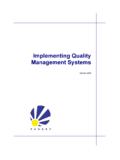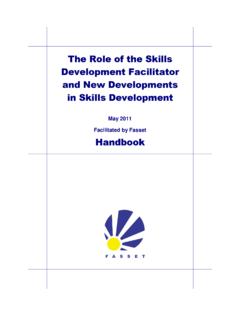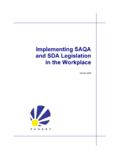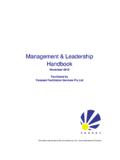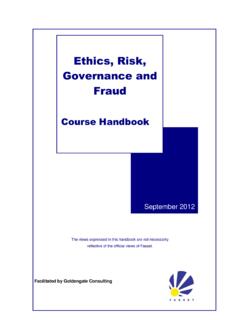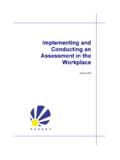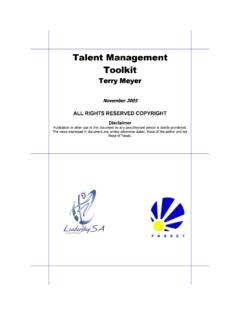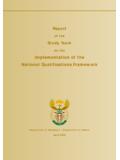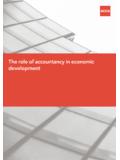Transcription of The Role of the SDF and New Developments in …
1 1 the role of the SDF and New Developments in skills DevelopmentFasset skills development Fasset skills development Facilitator WorkshopFacilitator Workshop1 AgendaTimeContent08h00 Registration and Tea08h30 Fasset welcome08h35 Fasset speaker10h20 Tea break10h40 Fasset speaker continued12h20 Lunch13h00 Fasset speaker continued14h20 Comfort break14h40 Fasset speaker continued16h00 Closure22 Section 1: Structures, relationships & skills development legislationSection 2: Assessment & the national Qualifications Framework (NQF)Section 3: Understanding learning programmesSection 4: Developing the strategic role of the skills development Facilitator (SDF)Section 5: Developing & implementing a Workplace skills Plan (WSP)Section 6: Organising Framework for Occupations (OFO)Section 7: Levies, grants & Fasset-funded Interventions3 OverviewStructures, relationships and skills development legislationSection 143 Legislative overview Legislation.
2 South African Qualifications Authority Act 1995 skills development Act 1998 skills development Act (Amended) 2008 skills development Levies Act 1999 national Qualifications Framework Act (2008) Quality Council for Trades & Occupations (2010) Revised Acts: Higher Education Act General and Further Education & Training Act5 skills development Act skills development Act (SDA) promulgated in 1998 to: Develop skills of SA workforce Increase levels of investment in education and training in the labour market Improve the return on investment Encourage employers to use the workplace as an active learning environment Provide employees with opportunities to acquire new skills Amendments to the Act in 2008 Ministry changed from DoL to DHET in Nov 2009 Established an institutional and financial framework.
3 64 SDA continued national skills Authority (NSA) national skills Fund (NSF) Levy-grant scheme Sector Education and Training Authorities (Setas) Labour centres of the Department Accredited trade test centres skills development institutes Quality Council for Trades and Occupations (QCTO) skills development forum for each province national Artisan Moderation Body Productivity South Africa7 skills development Levies Act (SDLA) SDLA promulgated in 1999 Intention of creating the rules around SDL collection Collected by SARS To finance skills development programmes International benchmark is that 5% or more is spent on training 1% of R500,000 total payroll per annum A European company is 6-8% A USA company is 5% In 2000 in SA, spend was of payroll 2002/2003 = (all) whereas large companies spent 85 Setas 23 different Setas per economic sector Main function.
4 To identify and address skills needs in their sector Compile and implement Sector skills Plan SDL grant claim process (Mandatory Grant) Establish and promote learnerships Facilitate discretionary grants and Seta programmes Quality assure education and training in their sectorResponsible for: Accredit training providers (quality checks, monitoring and moderations) Education and Training Quality Authority (ETQA)9 Funding of Setas Firms pay 1% of payroll as SDL to SARS 20% of 1% to NSF 80% of 1% to Setas 10% for Seta administration 50% to firms who claim Mandatory Grants 20% available for discretionary grants Unclaimed levies to projects Management Boards of Setas decide on strategy and allocation of funding to interventions106 Governing Ministry Department of Labour (DoL)
5 Governed the Setas up to 31 October 2009 from 1 April 2000 Setas were licensed for five year periods by the DoL DHET was created in July 2009 to address higher and further education needs Setas are now licensed by the Department of Higher Education and Training (DHET) Since 1 November 2009 Setas report to DHET DHET strategy will encompass the range of institutions under their management11 DHET strategy Five (5) programmes: Programme 1: Administration Programme 2: Human Resources development , Planning and Monitoring Coordination Programme 3: University Education Programme 4: Vocational and Continuing Education and Training Programme 5.
6 skills Development12713 NQF Act Setas acted as ETQAs ETQA function conferred in terms of SAQA Act 1995 SAQA Act repealed NQF Act (2008) NQF Act created 3 Quality Councils (QCs)148 Quality Councils 3 quality councils established via the NQF Act with 3 corresponding frameworks15 Name of Quality CouncilName of FrameworkCouncil on Higher Education (CHE) with its Higher Education Quality Committee (HEQC)Higher Education Qualifications Framework (HEQF)UmalusiGeneral and Further Education and Training Qualifications Framework (GFETQF)Quality Council for Trades and Occupations (QCTO)Occupational Qualifications Framework (OQF)Functions of the QCTO Design occupational standards and qualifications and submit them to SAQA for registration on the NQF Quality assurance, delivery, assessment and certification processes for occupational standards, qualifications and learning in and for the workplace Promote the objectives of the NQF Liaise with SAQA, Quality Councils (QC) and Professional Bodies (PB)
7 PBs may work with one or more QCs depending on the purpose, scope and design of the qualification169 SAQA Act 1995 SAQA Act promulgated in 1995. Responsible for: Overseeing the development and implementation of the NQF Formulating policy and criteria for registration of various bodies (ETQA/Standard Advisory Panels/ SGB s) Responsible for registration of unit standards and qualifications Ensure the unit standards and qualifications are Internationally comparable NQF Act of 2008 replaced SAQA Act but did not repeal SAQA17 NQF national Qualifications Framework Comprises 3 qualifications frameworks A vehicle for.
8 Eradication of injustice and achievement of reconstruction and development goals Transformation and promotion of quality in education and training1810 NQF continued It does this by: Creating an integrated national framework of learning achievements Facilitating access to mobility and progression within education, training and career paths Enhancing the quality of education and training Accelerating the redress of past unfair discrimination in education, training and employment opportunities Contributing to full personal development of each learner and the social and economic development of the nation19 ETQA Setas were accredited by SAQA to be ETQAs.
9 Check the status of workplace providers, training centres and education and training institutions Where the required standards are met, accredit theoretical training offered Accredit workplace providers so training could happen on the job Evaluate and moderate assessment Advise employers on which accredited training providers to use Assist with the evaluation of learning programmes Facilitate the training of workplace assessors 2011 Quality Assurance Partners Expertise in QA is traditionally located in PB s in sector Fasset has a decentralised model around QA, where expertise exists in PB s Quality Assurance Partner (QAP)
10 Model PB s accredit qualifications and training providers that fall within their scope For Fasset as a QAP In their traditional PB function21 Quality Assurance Partners continued No need to re-invent the wheel , use existing expertise which is appropriate and familiar to the sector There are advantages and disadvantages in the QAP model: Did not interrupt delivery in sector and create two parallel QA systems Practices of QAPs differ Professional bodies have now been absorbed into the NQF Act (2008)2212 Quality Assurance Partners continued Was researched and adopted as model for later QA structures PBs meet rigorous criteria to accredit education and training providers and are managed through a Service Level Agreement (SLA) with Fasset Current QAPs.
